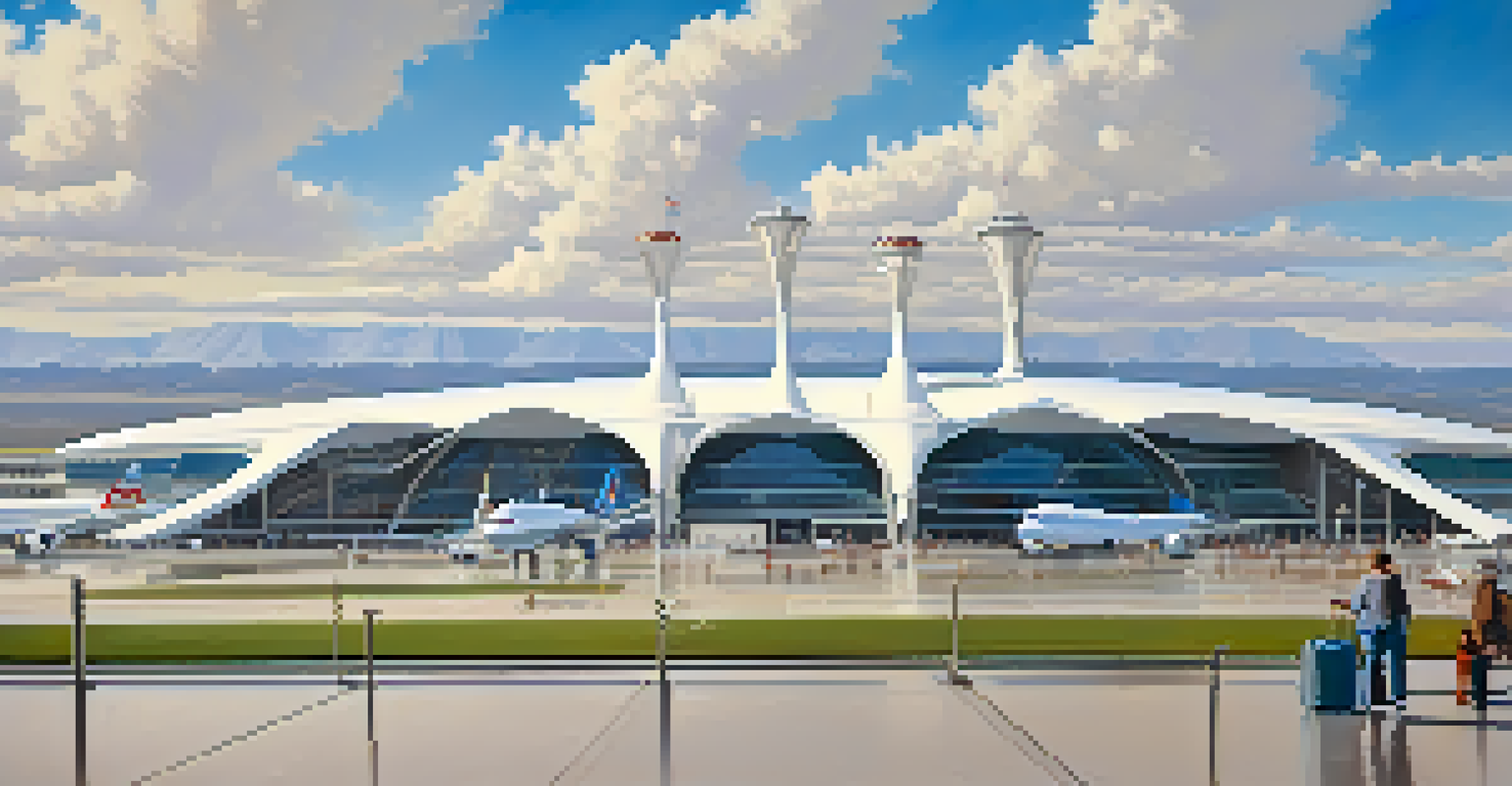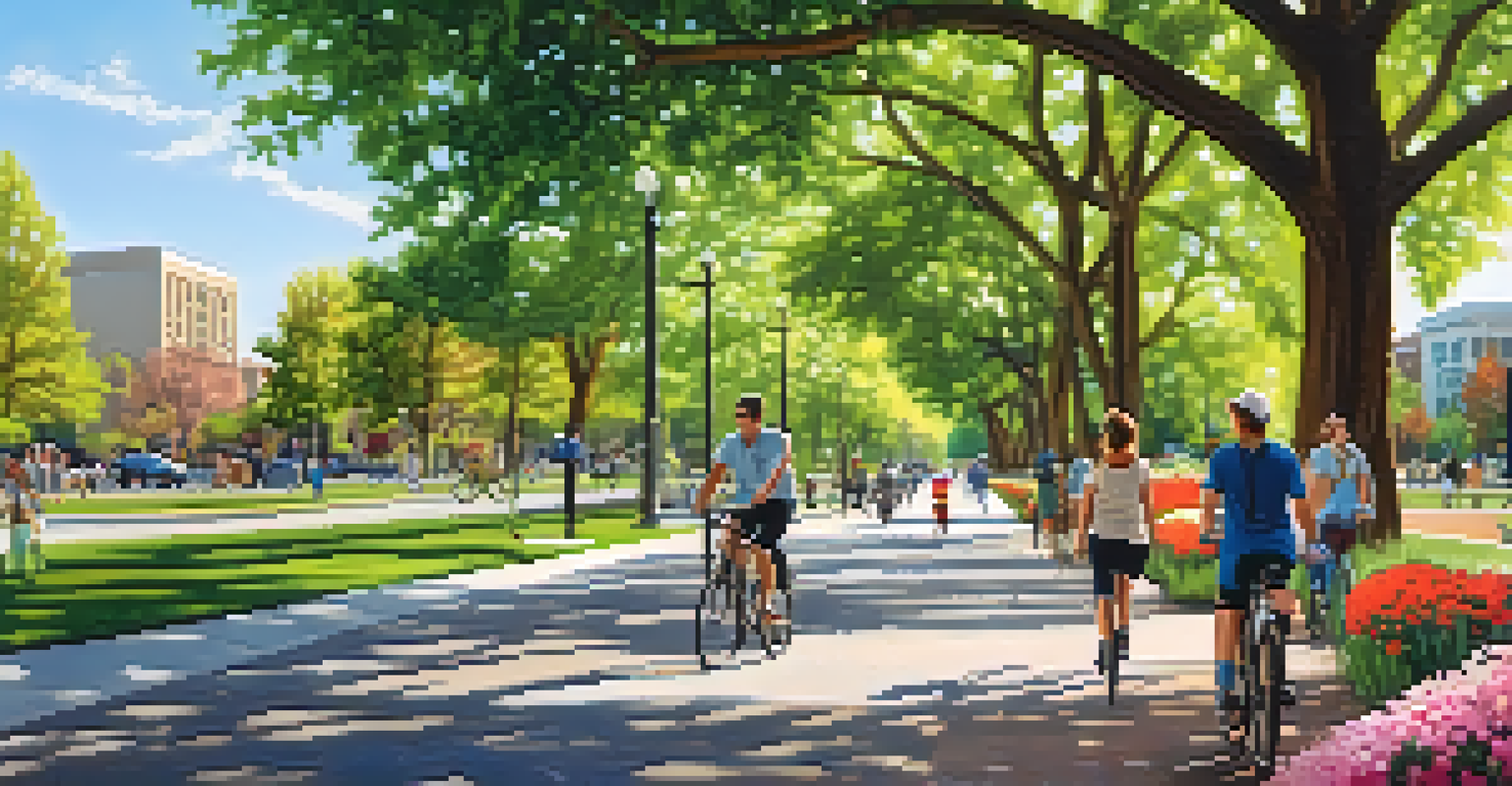Overview of Transportation Infrastructure in Denver: A Detailed Look

Introduction to Denver's Transportation Landscape
Denver's transportation infrastructure is a dynamic blend of various modes, including roads, public transit, and airports. This comprehensive framework plays a crucial role in connecting residents and visitors to the vibrant city and its surrounding areas. With the rapid population growth in Denver, the need for efficient transportation systems has never been more pressing.
Public transportation is a vital component of a sustainable urban future.
As a city known for its stunning natural scenery and urban appeal, Denver's infrastructure must support a diverse range of activities. Whether commuting to work, exploring local attractions, or traveling to the nearby Rockies, the transportation options available are essential for fostering connectivity. Understanding this landscape helps in appreciating the city’s commitment to improving mobility for everyone.
In this article, we will take a closer look at the various components of Denver's transportation infrastructure, how they work together, and the challenges they face in an ever-evolving environment. From roads to railways, let’s dive into what keeps Denver moving.
Road Infrastructure: The Backbone of Denver's Transport
Denver’s road infrastructure is extensive, featuring a network of highways, arterial roads, and local streets that facilitate daily commutes. Major highways like I-25 and I-70 serve as critical arteries that connect the city to neighboring regions and beyond. The quality and maintenance of these roads are vital for ensuring smooth travel and reducing congestion.

However, with the increasing number of vehicles on the road, traffic congestion has become a significant concern in Denver. City planners are continuously working on strategies to improve traffic flow, including road expansions, smart traffic signals, and alternative routes. These efforts aim to enhance safety and reduce travel times for commuters.
Denver's Transportation Diversity
Denver's transportation infrastructure includes roads, public transit, cycling, and air travel, all essential for connecting the city and its surroundings.
Moreover, the city has embraced sustainable practices by promoting carpooling and the use of electric vehicles. This not only helps in reducing the carbon footprint but also alleviates some of the traffic pressures on Denver's roadways, making for a more sustainable transportation future.
Public Transit: Buses and Light Rail Services
Public transit in Denver is anchored by a robust network of buses and light rail services, managed by the Regional Transportation District (RTD). The light rail system, which has expanded significantly since its inception, connects key areas of the city to surrounding suburbs, providing a reliable alternative to driving. This system not only eases congestion but also promotes eco-friendly travel options.
The best way to predict the future is to create it.
Buses complement the light rail by covering areas that are not easily accessible by train. With numerous routes and frequent service, RTD buses make it feasible for residents to rely on public transport for their daily needs. This accessibility is particularly beneficial for those who may not own a vehicle or prefer to avoid the hassles of parking.
In recent years, Denver has also implemented initiatives to enhance the user experience, such as real-time tracking and improved bus stops. These enhancements have encouraged more people to consider public transit as a viable option, contributing to a more sustainable and interconnected community.
Cycling and Pedestrian Pathways: Eco-Friendly Options
As part of its commitment to sustainability, Denver has made significant investments in cycling and pedestrian pathways. The city boasts an extensive network of bike lanes and multi-use trails that cater to cyclists and walkers alike. This infrastructure not only promotes a healthier lifestyle but also reduces reliance on motor vehicles, thereby alleviating traffic congestion.
Programs like bike-sharing initiatives have gained popularity, making it easier for residents and visitors to explore the city on two wheels. Additionally, Denver’s commitment to creating safe and accessible routes encourages more people to choose cycling as a daily mode of transportation. This shift not only benefits individual health but also contributes to a cleaner environment.
Sustainability Efforts in Transit
The city is investing in eco-friendly transportation options, such as cycling pathways and public transit enhancements, to reduce congestion and promote a healthier environment.
Moreover, the integration of pedestrian-friendly features, such as wider sidewalks and crosswalks, enhances the overall urban experience. As the city continues to grow, these investments in cycling and pedestrian infrastructure will play a vital role in shaping a more sustainable and vibrant Denver.
Air Travel: Denver International Airport
Denver International Airport (DEN) is a major hub for air travel, serving as a gateway to both domestic and international destinations. With its distinctive architecture and vast layout, DEN is one of the largest airports in the United States. The airport’s strategic location makes it an ideal transit point for travelers heading to various regions across the country.
Inside the airport, travelers can enjoy a range of amenities, including shopping, dining, and art installations that reflect the local culture. DEN is not just a transit point; it’s an experience in itself, with its impressive design and commitment to customer service. The airport also boasts advanced security measures and efficient operations, ensuring a smooth travel experience.
As the demand for air travel continues to rise, DEN is undergoing expansions and upgrades to accommodate more passengers and flights. These developments aim to enhance the overall experience for travelers while maintaining Denver’s reputation as a premier travel destination.
Challenges Facing Denver's Transportation Infrastructure
Despite its strengths, Denver's transportation infrastructure faces several challenges. Rapid population growth and urbanization have led to increased traffic congestion, straining existing systems. Additionally, funding for infrastructure projects is often limited, making it difficult to keep up with the growing demands of the city.
Moreover, maintaining and upgrading aging infrastructure presents a significant hurdle. Many roads and transit systems require repairs and modernization to ensure safety and efficiency. Balancing these needs with budget constraints is a constant challenge for city planners and transportation officials.
Challenges and Future Developments
Despite facing challenges like congestion and aging infrastructure, Denver is planning future expansions and smart technology integrations to improve mobility.
Lastly, the push for sustainable practices adds another layer of complexity. While there is a desire to expand public transit and cycling options, these initiatives require extensive planning and investment. Addressing these challenges will be crucial for ensuring that Denver’s transportation infrastructure can meet the needs of its residents for years to come.
Future Developments in Transportation Infrastructure
Looking ahead, Denver is poised to make significant advancements in its transportation infrastructure. Plans are in place to expand public transit options, including new light rail lines and enhanced bus routes. These developments aim to provide even greater connectivity and accessibility for residents and visitors alike.
In addition to public transit, there is a growing focus on integrating smart technology into the transportation system. This includes implementing intelligent traffic management systems and real-time data sharing, which can optimize traffic flow and improve safety. Such technological innovations are set to transform the way people navigate the city.

Moreover, Denver is committed to sustainability, aiming to reduce greenhouse gas emissions and promote more eco-friendly modes of transport. Initiatives like electrifying bus fleets and expanding bike-share programs are part of this vision. As these plans come to fruition, Denver’s transportation infrastructure will continue to evolve, making it a model for other cities to follow.
Conclusion: The Importance of a Strong Transportation Network
In conclusion, Denver's transportation infrastructure is a vital aspect of the city's growth and development. It serves as the backbone for connectivity, economic activity, and overall quality of life. As the city continues to expand, a well-planned transportation system will be essential for meeting the needs of its residents and businesses.
By prioritizing investments in roads, public transit, cycling, and pedestrian pathways, Denver is setting itself up for a more sustainable future. The city’s proactive approach to addressing challenges and embracing innovation positions it to thrive in the years to come.
Ultimately, a strong transportation network not only enhances daily commutes but also fosters a sense of community and accessibility for all. As Denver moves forward, its commitment to improving transportation infrastructure will play a crucial role in shaping a vibrant and livable urban environment.